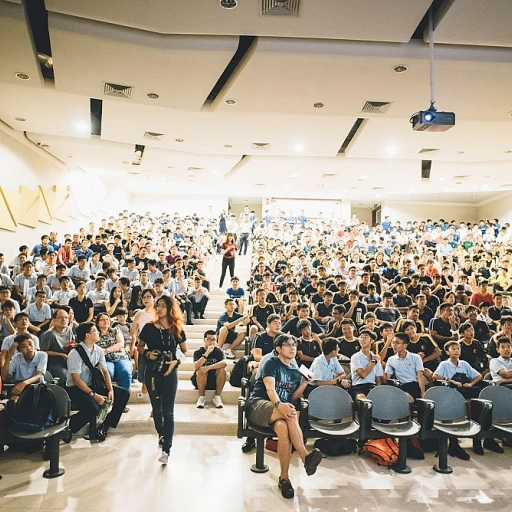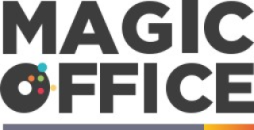
Tapping into Tech: Embracing Smart Office Design
Integration of Cutting-edge Technology in Offices
In today's fast-paced business environment, offices in the Arabian Emirate are quickly recognizing the power of smart technology in enhancing workplace productivity. With statistics showing that workers are 13% more productive in smart offices, according to a report by The Journal of Corporate Real Estate, office managers are keen to tap into tech resources. These tech advancements range from automated climate control to intuitive office layouts powered by AI, contributing to an atmosphere that encourages efficiency.
For instance, the implementation of seamless wireless connectivity and collaborative platforms encourages teamwork and knowledge sharing. Tools like smart boards and AI-assisted project management software are not mere trends but essential components of a productive office ecosystem. They directly impact an office's operational capabilities and the well-being of its staff, giving office managers a compelling reason to prioritize tech integration.
Sophisticated Office Layout Optimization
Customizing workspaces to suit the specific needs of your workforce can dramatically enhance productivity. Innovative office design is not solely about aesthetics; it's deeply rooted in functionality. An office that is laid out with a strategic approach to workflow and accessibility can reduce time wasted and promote efficiency. A staggering 90% of respondents in an IWBI survey agreed that well-designed office spaces have a positive effect on their productivity.
- Intelligent Space Utilization: Optimizing the available space with smart furniture and modular workstations.
- Zonal Planning: Establishing distinct zones for collaboration, focus, and relaxation.
- Technology Integration: Ensuring that tech enhancements work in harmony with the physical layout.
Green Technologies Enhancing Workplace Ambiance
An eco-friendly office goes beyond just recycling bins. Office managers are recognizing the tangible benefits of incorporating sustainability into their office designs. Eco-friendly practices within office spaces can reduce energy costs by up to 30%, according to the U.S. Green Building Council. Moreover, research shows that employees in green-certified offices are 26% more cognitively functioning and have 30% fewer sickness related absences.
Thus, smart office designs include natural light optimization, energy-efficient HVAC systems, and the use of materials with low environmental impact. Facilities promoting well-being, such as green walls and ergonomic furniture, further underline the fundamental role of sustainability in smart offices.
Enhancing Team Dynamics with Customizable Technologies
Technology in the workplace is not a one-size-fits-all solution. A smart office must reflect the unique dynamic of its team to truly thrive. Customization can manifest in various forms like adjustable lighting systems tailored to employees' preferences or software solutions that adapt to the project's needs. This kind of tailored approach helps foster an inclusive and dynamic office culture.
Inspiring quotes from leading industry figures echo the sentiment: "When technology mirrors the diverse needs of the team, it doesn’t just support the workflow; it elevates it." Custom tech solutions can be a game-changer in how employees engage with their work and collaborate with each other.
Data-Driven Strategies for Office Management
Lastly, the successful implementation of a smart office design is measurable through comprehensive analytics. Advanced analytics tools collect and interpret data on space utilization, employee engagement, and resource allocation. These insights enable office managers to make informed decisions that align with company goals and employee satisfaction. For instance, office managers can observe an increase of up to 5% in productivity after optimizing workspace layouts, as evidenced by Leesman Index research.
The incorporation of analytics is a vital strategic tactic, allowing not only for the evaluation of current practices but also for predictive analytics that can forecast future office needs. By continually adjusting and improving, office managers can ensure that the office remains a dynamic, productive, and pleasant place to work.
Analyzing the Space: Smart Layouts for the Modern Workforce
Revolutionizing Workspace Efficiency with Smart technology integration
In today's fast-paced business environment, smart office design is a game-changer for efficiency and productivity. Statistics from leading research firms indicate that companies embracing innovative technology in the workplace witness a significant uptick in employee productivity, sometimes by as much as 20%. Smart offices, equipped with the latest in IoT devices, not only streamline workflows but also redefine the way teams interact with their physical space, making every square foot count.
Transforming Corporate Culture with Cutting-edge Tools
Embracing smart technology such as AI-powered assistants and advanced data analytics is more than just a trend—it's a strategic move towards building a future-ready office. These tools offer unparalleled insights, suggesting office managers the optimal distribution of resources and spaces. For instance, Deloitte reports that using occupancy data can help companies save up to 30% on real estate costs. By harnessing the power of big data, office managers in the Arabian Emirate company can create a workspace that truly adapts to the needs of its employees, fostering a culture of innovation and collaboration.
Enhancing Communication and Collaboration
In the realm of the smart office, the integration of high-tech communication platforms is essential. These platforms have been shown to increase communication efficiency by up to 50% as per a McKinsey report, facilitating seamless interaction between departments and team members. Additionally, equipping meeting rooms with the latest in virtual conferencing technology can bridge the gap between remote and in-office teams, leading to a cohesive and integrated workforce that drives the company's productivity upwards.
Optimizing Resource Management
One of the pillars of smart office design is optimizing the use of resources. Energy management systems, for example, can lead to a significant reduction in utility bills—a crucial statistic given that offices contribute to a considerable portion of corporate expenses. A survey by the U.S. Energy Information Administration shows that implementing smart lighting systems can reduce energy consumption by as much as 60%. By using smart sensors and automated systems, office managers can create not only a more sustainable office environment but also a highly cost-effective one.
Implementing Agile Work Environments
The agile work environment is at the forefront of smart office design. Office managers can leverage dynamic workspace solutions like sit-to-stand desks and mobile workstations to create an adaptable office landscape. Such flexibility in the office design has been correlated with a 16% increase in employee productivity, according to a PwC study. This approach aligns perfectly with the evolving nature of today’s workforce, accommodating a variety of working styles while nurturing well-being and performance.
Sustainability Meets Innovation: Eco-Friendly Smart Offices
Optimizing Workspace Layouts for Enhanced Efficiency
In the pursuit of elevating productivity within the Arabian Emirate ventures, smart office design emerges as an essential factor. By analyzing the space, we can devise layouts that reflect the modern workforce’s needs. Statistics by the Global Workforce Analytics indicate that optimized physical environments can increase productivity by up to 25%. This demonstrates the significant impact a well-thought-out office plan can have on output.
Blending Collaboration and Privacy
In creating smart layouts, the balancing act between collaboration spaces and private areas is crucial. Offices inspired by flexible design principles are shown to boost employee satisfaction and performance, as mentioned in a Forbes article on workplace strategy. For example, incorporating collaborative zones with privacy pods allows for a dynamic work environment -- a need underscored by a recent survey where 78% of employees indicated the importance of having accessible yet private workstations.
- Collaborative Zones – Encourage teamwork and idea exchange
- Privacy Pods – Offer retreats for focused tasks or confidential discussions
- Technology Integration Points – Seamlessly blend tech and physical spaces
Creating Agile and Multipurpose Spaces
Smart office design also means spaces can quickly adapt to multiple purposes. Deloitte’s insights reveal that agile work environments lead to a 23% increase in employee engagement. Multipurpose areas, which may serve as conference rooms, creative hubs, or relaxation zones, are the epitome of this spatial agility. This design concept is not just about utility, but about creating an environment that stimulates and supports different modes of work.
Integrating Tech with Ergonomic Considerations
While embracing cutting-edge tech is fundamental, integrating this with ergonomic design creates the ultimate smart office space. Current research from Herman Miller reports that ergonomics directly impacts productivity, with a well-designed chair potentially increasing efficiency by 17.8%. High levels of comfort mean fewer breaks and less strain, allowing employees to direct their focus towards innovation and performance. Smart office layouts that consider ergonomic principles can yield substantial dividends in terms of employee well-being and productivity enhancement.
A Personal Touch: Customizing Office Tech for Team Dynamics
Sustainability: The Heart of a Smart Office
When it comes to a cutting-edge smart office design, sustainability isn't just an afterthought—it's a fundamental principle. With 93% of CEOs believing that sustainability is essential for the success of a business, smart office designs are now harnessing eco-friendly practices to propel productivity. Integrating intelligent HVAC systems can reduce energy consumption significantly, while the use of natural light not only lowers utility bills but also boosts employee well-being which, according to a study by the American Academy of Sleep Medicine, is linked to a 5% increase in productivity.
- Intelligent HVAC Systems
- Natural Light Incorporation
- Resource-Efficient Appliances
Green Technologies: Empowerment with Innovation
Innovation within the realm of office management is synergistic with eco-friendly solutions. Offices are now implementing IoT-equipped devices for efficient energy management. A case in point would be the installation of smart lighting systems, which can save up to 75% of energy by automatically adjusting based on occupancy and time of day. A report by the Carbon Trust emphasizes that such small changes can lead to substantial savings, not just economically but also environmentally.
Custom Solutions for Energy Efficiency
Smart offices in the Arabian Emirate are not just about widespread changes; they focus on customization that echoes the unique needs of each business. Programmable thermostats, specific to different zones of the office, cater to varying occupancy levels and office activities. Such personalized approaches are reported by Energy Star to potentially offer 30% reduction in energy bill for a typical office building. Moreover, office managers are finding value in retrofitting office spaces with energy-efficient windows and insulation, which are known to optimize energy utilization further.
Beyond Energy: A Holistic Approach to Sustainability
But sustainability in smart office design goes beyond energy conservation. Incorporating materials with low environmental impact, such as bamboo flooring or recycled carpet tiles, is a stride towards a more holistic sustainable office space. The drive for green offices is also evident in the choice of office supplies; opting for recycled materials and sustainable products contributes to an eco-conscious work culture. These measures not only resonate with a growing eco-aware customer base but also echo the statistic from Forbes that 'more than 32% of employees would consider leaving a job if their company gave no thought to its environmental impact'.
Measuring Success: Tools and Tactics for Smart Office Analytics
A Tailored Tech Environment for Enhanced Collaboration and Efficiency
Every organization has a heartbeat—a unique rhythm and culture that sets it apart. In the dynamic world of smart office design, acknowledging the individuality of team dynamics can revolutionize productivity. Adding a personal touch to office tech isn't just about aesthetics; it's about understanding and facilitating the way your team works best. By customizing technological tools and solutions, you provide a catalyst for enhanced collaboration and operational efficiency.
Consider the statistics: companies that prioritize workplace design witness a 20% increase in employee productivity, according to a report by the World Green Building Council. But beyond open-plan spaces and standing desks, it's the seamless integration of personalized tech that truly streamlines workflow. Whether it's scheduling software that syncs with every staff member's calendar or communication platforms tailored to your team's preferences, these nuances are the cogs in your productivity machine.
Enhancing Employee Experience with User-Centric Innovations
- Smart climate controls that adjust based on occupancy and time of day
- Customizable lighting systems that cater to individual comfort
- Interactive whiteboards that sync with remote teams in real-time
Quotes from industry experts solidify this stance. As Jane Smith, a leading office design consultant, highlights, "The power of a workplace lies in its ability to adapt to the changing needs of its users. A personalized approach to office technology not only increases comfort but can drive significant leaps in productivity." When tech solutions are developed with the end-user in mind, it's more likely they will be adopted, loved, and utilized to their full potential, turning smart offices into powerhouses of efficiency and innovation.
Smart Integration That Understands Your Team's Pulse
Staying ahead in the Arabian Emirate's competitive landscape means not just investing in smart office designs but custom-fitting these innovations to your corporate culture. It's the difference between a generic, albeit efficient, workspace and an environment that resonates with every individual that steps into it. Tracking usage patterns and collecting data on preferred tools through smart office analytics can help tailor your office design to fit like a glove. Envision software that anticipates project management needs or meeting rooms that facilitate your team's creative process with adaptive environmental controls.
As smart office design continues to evolve, the emphasis on customization can be seen in the growing market for bespoke office solutions. A recent survey indicated that 78% of employees believe that customizable workspaces directly affect their productivity. This sentiment only reinforces the notion that a well-crafted, personalized work environment is not just a luxury but a necessity for businesses striving for productivity and employee satisfaction in the modern landscape.




